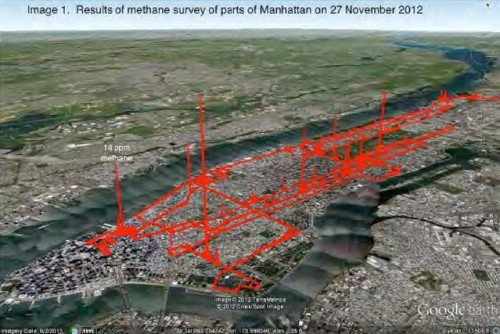Manhattan Natural Gas Pipeline Emissions
March 27, 2013Manhattan Natural Gas Pipeline Emissions Press Release
March 27, 2013Media: New Study Exposes How Natural Gas Isn’t the Clean Fossil Fuel It’s Hyped up to Be
This Final Report, commissioned by Damascus Citizens for Sustainability, concludes that there is no advantage to natural gas over coal or oil, in terms of climate impact. Download the Final Report. View the Press Release.
Extended Report on a Preliminary Investigation of Ground-Level Ambient Methane Levels
in Manhattan, New York City, New York
March 11, 2013
Robert Ackley and Bryce F. Payne Jr. , PhD
Gas Safety, Inc., Southboro, Massachusetts
EXECUTIVE SUMMARY
DCS requested that GSI extend the work effort described in our initial Report on a Preliminary Investigation of Ground-Level Ambient Methane Levels in Manhattan, New York City, New York (16 December 2012) to assess the practicality of developing an estimate of methane emissions in Manhattan. Specifically the effort was to focus on providing an estimate of methane emissions that could be used in evaluating the role of natural gas leakage in Manhattan with respect to fossil fuel dependence, climate impacts and other environmental and economic concerns.
Currently the greenhouse gas equivalence of methane is widely accepted as at least 20 times the effect of carbon dioxide over a 100-year time frame. In other words, leakage of 1/20th, or 5%, of the methane moving through a natural gas production-transport-distribution system will effectively double the greenhouse gas impact of the use of that natural gas. That is, leakage of only 5% of natural gas from point of production to point of use would eliminate any greenhouse gas advantage of natural gas compared to other fossil fuels. More complex efforts by others have looked into the greenhouse gas emissions advantages of using natural gas instead of other fossil fuels. It appears that those more elaborate efforts are settling in at ≤3.2% gas loss to leakage as the maximum leakage rate at which use of natural gas retains an advantage. Hence, the loss of even a few percent of gas during production, transport, distribution and utilization is critically important to management and planning of present and future national and international energy supply and utilization systems. Therefore, it was concluded the extended GSI work effort should be focused on the need to assess total methane emissions. The available data was from Manhattan. Among the production, transport, local distribution and utilization systems, this work addressed the collective effect of only local gas distribution and utilization systems, along with any other methane sources that might be present in Manhattan.
GSI efforts for this extended report focused on three objectives: (1) find existing estimates from industry, government or other sources, of the amount of methane being released in Manhattan, (2) develop such an estimate from the ground-level methane data collected during our preliminary investigation of methane levels in Manhattan, and (3) compare those estimates and consider their implications with regard to broader environmental and economic concerns. Since this investigation was limited to Manhattan (augmented with comparative data from the Bronx, and other areas across New York and Connecticut), ConEd is the relevant gas distribution company.
An examination of existing estimates, or methods for estimating, methane emissions led to the conclusion that such estimates have little basis in actual data. Natural gas companies are required to file yearly reports of Lost- and-Unaccounted-for (LAUF) gas. Presumably these reports would approximate the amount of gas leaked from the pipelines and other infrastructure of the reporting companies. However, the meters in those gas systems are only required to be accurate to ±2%. Each such system may contain hundreds of thousands of meters. Each meter is subject to normal wear and tear. Another problematic issue is the reported LAUF gas volume may incorporate other gas volumes by rule, contract, regulation, or for other administrative reasons. Consequently, the annual reported LAUF gas volumes should not be regarded as reliable estimates of the amounts of gas actually lost or emitted to the atmosphere. However, since the LAUF gas volume is ultimately based mostly on measurements using meters that are accurate to ±2%, it follows that long-term average LAUF values should provide a reasonably meaningful mean with a ±2% variability. A ten-year average LAUF for ConEd was 2.2% with a range of 0.4 to 4.3%, i.e, ±2% variability. The 10-year-average-LAUF based estimate of annual methane emissions for the entire ConEd system was 2.2% or about 6.6 billion cubic feet per year.
The apparently most widely used method for estimating gas leakage and methane emissions from gas pipelines appears to be from a 1996 report by the U.S. Environmental Protection Agency and the Gas Research Institute (EPA/GRI). Estimates generated using the EPA/GRI 1996 method have such a wide confidence interval (±65%) that their general accuracy and usefulness is questionable. The report recognizes the likely importance of gas leaks that are undetectable by the standard industry leak detection practice, but the estimation method makes no attempt to account for such undetectable leaks. Finally, a related report of a more thorough study of cast iron pipelines in Brazil, suggested that the EPA/GRI method may provide estimates that are too low by almost half. Application of the EPA/GRI method to the pipeline statistics for the entire ConEd system generated an estimated methane emissions rate of 1 billion cubic feet per year, which can be meaningfully compared to the 10- year average ConEd LAUF gas estimate of 6.6 billion cubic feet per year. Since most leakage in gas delivery systems occurs from the pipes in the system, such a disparity between the EPA 1996-based estimate for ConEd pipeline leakage and the 10-year average ConEd LAUF gas volume would seem to indicate problems in one or both of those estimates.
During the research for this Report, we thoroughly reviewed the methane data collected by GSI during the previously reported Preliminary Investigation of Ground‐Level Ambient Methane Levels in Manhattan. We also reviewed the meteorological literature and meteorological data available for Manhattan. Based on that information we developed a simple model (patent pending) that could process our preliminary Manhattan methane data and meteorological data from local sources to generate a preliminary estimate of total methane emissions in Manhattan. The resulting estimate was the flow of methane to the atmosphere from all sources in Manhattan. Such an estimate can be used to assess the relative importance of those emissions in terms of methane as a greenhouse gas (GHG) and the relative impact of gas service/use in Manhattan in a broader climate/GHG context. Wherever reasonable in the application of the model, input values were selected conservatively, so that any errors in the result should be to the low side.
The resulting methane emissions estimate for Manhattan alone was 8.6 billion cubic feet per year, or about 2.86% of the 300 billion cubic feet of gas handled by the entire ConEd system each year, even though Manhattan comprises only about 5% of the land area and one-third of the customers in the ConEd service territory. There are also substantial losses that occur in the natural gas system before natural gas reaches the ConEd distribution system. It, therefore, appears inevitable that the loss of gas in the system serving NYC via ConEd is above the simple critical level of 5%, and well above the more elaborately derived critical levels of ≤3.2%. That is, the methane leakage in the system serving NYC through ConEd is likely already at a level where the methane leaked has as much or more climate impact as the remaining approximately 95% of the gas that is actually usefully burned by consumers in NYC. This necessarily raises doubts about the claimed value of natural gas as a “clean bridge fuel”. Further work should be done to verify the findings we report here and to identify specific methane sources, as well as to improve natural gas leak prevention and management. Furthermore, the evidence suggests that leakage from natural gas systems has a more substantial role in climate change than was believed that has only recently begun to be appreciated.




